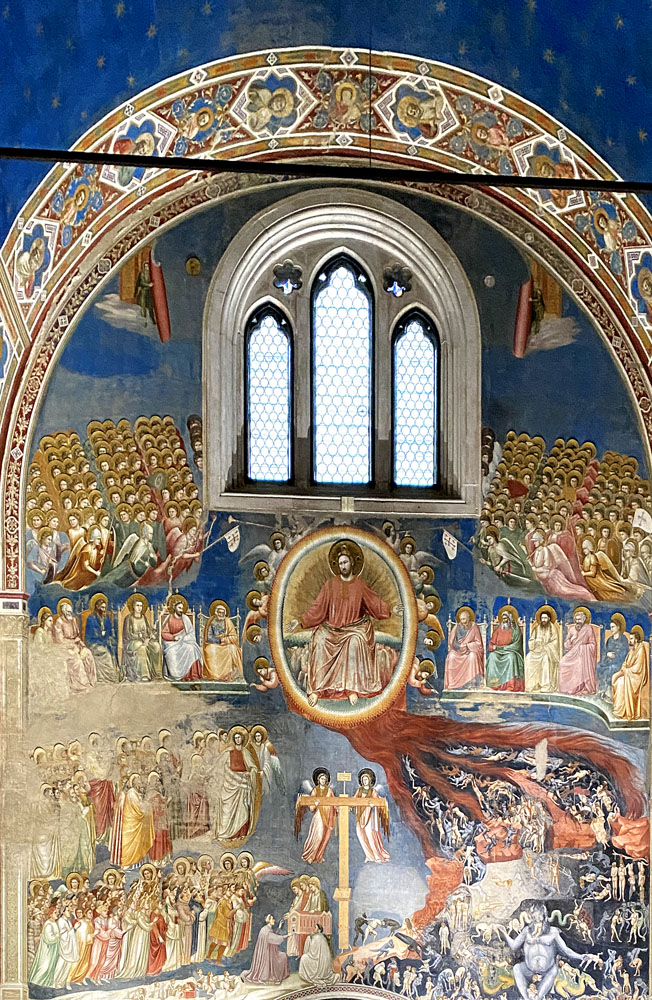
Giotto
The Last Judgment
1303-1305
Fresco
Scrovegni Chapel, Padua
This grand fresco covers most of the chapel's
counterfaçade.
A double white line divides it into two registers, one above for Christ in Heaven and one below for the actual judgment of the saved and damned souls. In the center of the upper register Christ sits on a rainbow in a mandorla. The rainbow is common in medieval images of the Last Judgment and also in at least one image of
Daniel's vision of the Son of Man. It alludes to Revelation 4:3, "there was a rainbow round about the throne."
That chapter continues, "And in the sight of the throne was, as it were, a sea of glass like to crystal; and in the midst of the throne, and round about the throne, were four living creatures, full of eyes before and behind." (Revelation 4:6). The four creatures, representing the four evangelists, are at Christ's thighs in Giotto's image: St. John's eagle and St. Mark's lion on the right, and on the left the ox of St. Luke and an odd construction that must represent St. Matthew. The green area beneath Christ's feet may be an allusion to the "sea of glass" in the text. Four of the angels that surround the mandorla blow trumpets, a sign of the Last Judgment mentioned again and again in the New Testament.1
The twelve Apostles sit left and right of the mandorla, above them multitudes of saints guarded by angels with weapons and military garb. Above the multitudes, two angels reveal the doors to Heaven by unwinding the sky as if it were a curtain or veil. "Revelation" literally means the removal of a veil. This detail of the image does not correspond directly to anything in Revelation, but it may refer to the "new heaven" of Revelation 21:1.
On the left side of the lower register the dead rise from their tombs and are conducted by angels to the judgment. Among them are a Franciscan and a Dominican standing together. Above them are those who have been saved, each bearing a halo. Front and center in that group is Moses, identified by his horns. Perhaps the man standing with him is Aaron. On the right side of the lower register Satan and his minions torture the damned souls, often in ways sexually perverse.
Christ's cross stands between the two halves of the lower register, held up by a mysterious figure most of whose body is hidden behind the wood. He seems to have a halo.
To the left of that mysterious figure, Enrico Scrovegni and a man with a tonsure present a maquette of the Scrovegni Chapel to three female figures, identified by the Web Gallery of Art as the "three Marys" who found Jesus' empty tomb in Mark 16:1-5. It is not clear to me why the three figures in the fresco would be those particular women, though a reference to the Resurrection would not be amiss in the context.
The man with the tonsure could represent the Augustinian friars who had a church next to the Scrovegni Chapel. The chapel in the fresco has an apse at the east end, but this was later demolished owing to the friars' insistence that Scrovegni's private chapel should not look or function as an alternative to their church.2
View this image in full resolution.
Read more about images of the Last Judgment.
Photographed at the chapel by Richard Stracke, shared under Attribution-NonCommercial-ShareAlike license.
1 Matthew 24:31, I Corinthians 15:52, Thessalonians 4:15, Hebrews 12:19, Revelation 8:1-21,10:7,11:15.
2 Wikipedia, s.v. "Scrovegni Chapel."